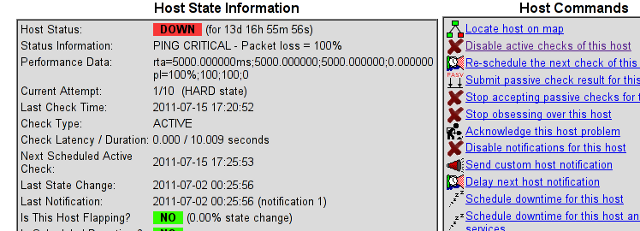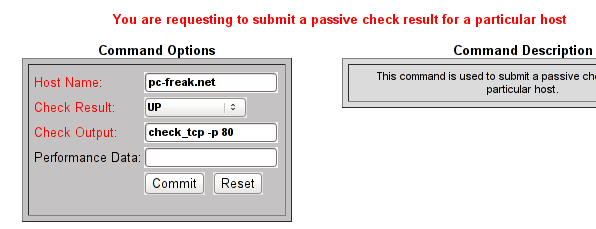At the company where I administrate some servers, they’re running Nagios to keep track of the servers status and instantly report if problems with connectivity to certain servers occurs.
Now one of the servers which had configured UP host checks is up, but because of heavy ICMP denial of service attacks to the servers the ICMP protocol ping is completely disabled.
In Nagios this host was constantly showing as DOWN in the usual red color, so nagios reported issue even though all services on the client are running fine.
As this is quite annoying, I checked if Nagios supports host checking without doing the ICMP ping test. It appeared it does through something called in nagios Submit passive check result for host
Enabling the “Submit passive check result for this host” could be done straight from Nagios’s web interface (so I don’t even have to edit configurations! ;).
Here is how I did it. In Nagios I had to navigate to:
Hosts -> Click over my host (hosting1) which showed in red as down

You see my down host which I clicked over showing in red in above pic.
On next Nagios screen I had to select, Disable active checks of this host

and press on the Commit button.
Next following text appears on browser:
Your command request was successfully submitted to Nagios for processing.
Note: It may take a while before the command is actually processed.
Afterwards I had to click on Submit passive check result for this host and in:
Check Output to type in:
check_tcp -p 80
Here is the Screenshot of the Command Options dialog:

That’s all now Nagious should start checking the down host by doing a query if the webserver on port 80 is up and running instead of pinging it.
As well as the server is no longer shown in the Nagio’s Down host list.
More helpful Articles

Tags: Button, check result, checks, client, command options, command request, Commit, company, connectivity, denial of service, denial of service attacks, downYou, host, host list, hosts, ICMP, icmp ping, icmp protocol, Nagio, nagios, Output, ping, ping test, processing, request, screen, screenshot, servers, something, status, Submit, test, text, type, web interface








Mozilla/5.0 (Windows NT 6.1; WOW64; rv:12.0) Gecko/20100101 Firefox/12.0
Hi,
View CommentView CommentDo you have any idea how to do this on multiple host let say for 100 hosts? Do I have to do it manually 1-by-1?
Opera/9.80 (X11; Linux x86_64; U; bg) Presto/2.7.62 Version/11.00
Hi,
Maybe you can check what kind of config is generated while clicked on to one of the unreachable hosts?
View CommentView CommentThose conf might contain something concerning the disabled host you might take and later use some shell script to generate same config variables and place them in config?
Mozilla/5.0 (Windows NT 6.1; WOW64; rv:12.0) Gecko/20100101 Firefox/12.0
Hi,
Thanks for your advice. I managed to do this by putting these host into one hostgroup and then I’ve assigned host check to that hostgroup to active check it using check_tcp on port 443 (I use SSL). In this way you can do it for a larger deployment and the same time get the benefit of active check.
View CommentView CommentMozilla/5.0 (Windows NT 6.1; WOW64) AppleWebKit/536.11 (KHTML, like Gecko) Chrome/20.0.1132.57 Safari/536.11
Falai ai galera!!!!
Define a dummy service for SUCCESS
# Dummy SUCCESS command, used for host we no means of checking
define command{
command_name SUCCESS
command_line $USER1$/check_dummy 0
}
Then in your host definition, use
check_command SUCCESS
The host will then be presumed to be up, so the service will be checked.
Simples like that!!!! Simples assim!!! Sou fã do nagios!!
View CommentView Comment